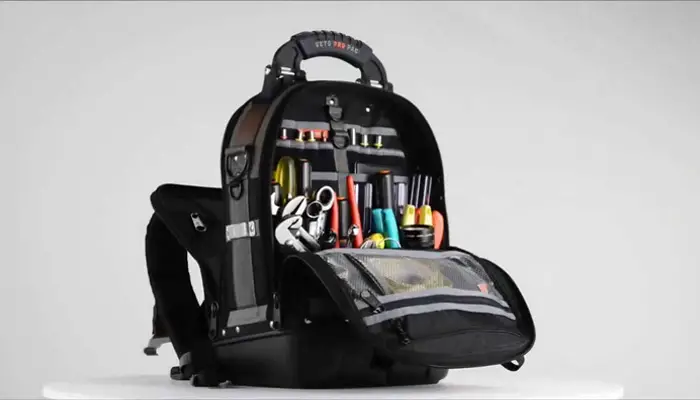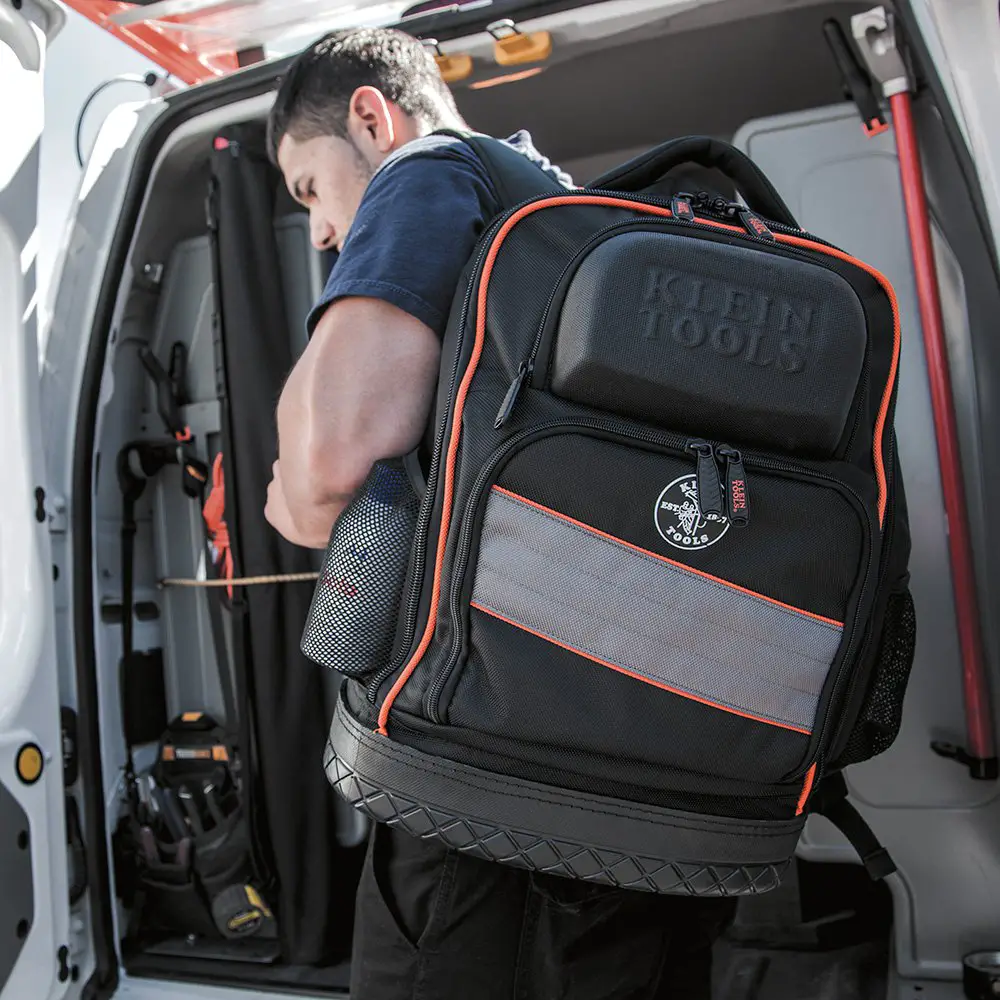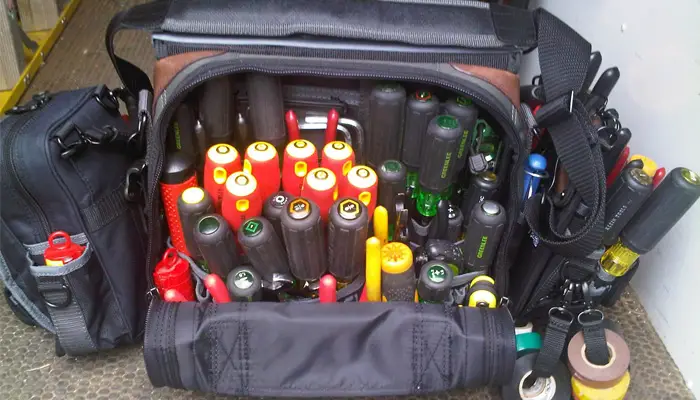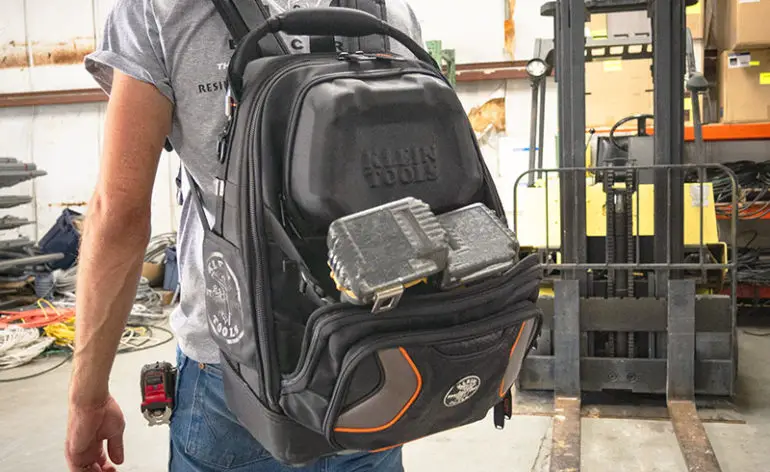Good tool backpacks definitively enable better productivity at work. The backpacks can be divided by many criteria.
The most important are – size, a number of tools to cope and tool size, internal organization, and closing style, durability and resistance, weight, price, and handyman type. There are also special backpacks.

Size
Size is very important criteria when it comes to the choice of a backpack for tools. Backpacks are divided into big ones and small ones.
The big ones are usually 15+ inches long. The width and thickness of the backpack don’t have strict criteria. Recommendable width, to be placed in the row of large ones, is 12+ inches, but the height is definitively the most important factor.
Some backpacks can be very thick, but this doesn’t necessarily mean the backpack will be big. The thickness will tell more about backpack functionality and the number of internal loops.
The thickness may also tell more about the backpack profile – thicker backpack definitively means an ability to place more tools. This is important when it comes to the determination of the best tool backpack for various types of handymen – roofers, masons, electricians, decorators, plumbers…
The too big backpack may leave too much free space, while too small backpack affects negatively on production rate.
Number of tools to cope and tool size
Tools and protective equipment are extremely important for every handyman. It is also determined by the profession. For example, a carpenter carries fewer tools, but his tools are bigger.
An electrician carries more tools, but his tools are smaller. Some handyman needs to carry a lot of protection equipment – gloves, helmet, protection goggles, handyman suit, boots…
A total number of items is considered. If a handyman carries over 25 items, it is guessed he needs a big backpack.
But this is not a strict rule. For example, an electrician, or a handyman for thermal and cooling devices can carry over 30 items, but a small backpack will do the thing. Many of their items are not taking up too much space.
Before you determine which tool backpack is suitable for you, calculate accurately the size of your tools and its number.
Internal organization and closing style

The most important thing about the internal organization is the number of pockets and loops. Some best tool backpack comes with a lot of pockets and loops while some backpacks with a small number of pockets and loops.
However, there are also backpacks with big loops and pockets and backpacks with small loops and pockets.
In addition, there are backpacks with internal pockets and backpacks with external pockets.
A big number of pockets is not good if the pockets, for example, are too small and not practical. Too big loops enable tools to knock into each other, which increases the possibility of damage.
There are two types of closures – bucket-style and zip style. Bucket-style opens at the top and presents a good solution for easy access, and zip style is excellent if you work on a ladder or on tight space.
Durability and resistance
Material and rubber tray on the bottom are the key things. If the backpack has a rubber tray on the bottom, which means the backpack is definitively more resistant.
Plus, if it is made of good material, like polyester, this also improves durability. And if the backpack is double-stitched at weak spots, this is also a big plus. The best tool backpacks are those that are also waterproof.
Weight
There are ultralight backpacks, light backpacks, and heavy backpacks. Ultralight weighs under 2 lbs, light under 4 lbs, and heavy backpacks weight over 4 lbs.
Price
Definitively, a price is the most limiting factor. If you don’t have enough money, it limits the choice. Cheap backpack costs to 60 dollars and intermediate one costs 60-100 dollars, and an expensive one above 100 dollars.
Tool Backpacks for Different Handyman type
There are various types of handymen, and each type has different requirements.
Carpenter
Carpenters need a backpack which is wider and thicker. There is no need for more than 2 loops on the inside. Zip closure is thought to be a better choice. A backpack needn’t be reinforced with the rubber tray. Extra comfort and back pads are preferred.
Electrician

An electrician needs a small backpack, with a lot of loops and pockets, both inside and outside of the backpack. A place for screwdrivers, cordless drill, charger, a wrench set, and pincers is a must. Zipped closure with enabled one-handed working is a better choice.
Safety straps are a recommendation for better stability. A handyman for cooling and thermal devices has very similar criteria like an electrician since their tools are having similar dimensions.
Decorator
Decorator needs a taller backpack, which also has a zip closure and which enables work on the ladder. There is no need for many loops, but it is good if there is a bigger number of pockets for smaller tools. Rubber tray is preferred.
Plumber
A plumber may carry a bucket-style bag, with many loops, with a rubber tray reinforcement on the bottom. However, if the backpack has a flashlight or LED light, this may be a perfect choice.
An average number of pockets is needed. Plumbers may work in the dark. A zip-closure style is also acceptable. The backpack must stand flat when placed on the ground. A ceramist has similar criteria like a plumber, with two differences – no need for a flashlight and there is no need for too many pockets.
Mason
A mason looks for a taller and wider backpack, with a special unit for the helmet and protective equipment. Zip closure is a better choice, one big loop on the inside may do the job and only a few pockets.
Whitesmith

A whitesmith needs to carry a lot of tools at once, zip closure is a must, just as climbing tools. One-handed working is a must. This job is very dangerous because a whitesmith is always on the edge, so a good safety rope is needed in the combination with a bit bigger, but light or ultralight backpack.
Safety straps for the backpack are recommended. A roofer has very similar criteria with one difference – a backpack can be smaller.
A universal handyman carries the best backpack for tools which is similar to the backpacks that are carried by the electricians. A backpack only needs to be a bit bigger.
Special Backpacks
Special backpacks stand by one or more characteristics out among other backpacks. For example, a special backpack may be the one with pre-installed LED lights or custom made hooks.
Any detail that is specific on some backpack, and is not present in other general types of a backpack, makes the backpack special.
Leave a Reply